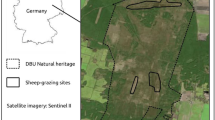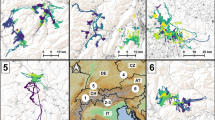Abstract
In this study, we sought to understand how landscape structure affects roe deer movements within their home-range in a heterogeneous and fragmented agricultural system of south-western France. We analysed the movements of 20 roe deer fitted with GPS collars which recorded their locations every 2–6 h over several months (mean = 9 months). Based on empirical observations and previous studies of roe deer habitat use, we hypothesised that roe deer should avoid buildings and roads, move preferentially along valley bottoms and through the more wooded areas of the landscape. To test these hypotheses we paired each observed movement step with 10 random ones. Using conditional logistic regression, we modelled a step selection function, which represents the probability of selecting a given step as a function of these landscape variables. The selected model indicated that movements were influenced by all the tested landscape features, but not always in the predicted direction: our results suggested that roe deer tend to avoid buildings, roads, valley bottoms and possibly the more wooded areas (although the latter result should be interpreted with caution, as it may be influenced by a bias in the rate of GPS fix acquisition in woods). The distances to buildings and to roads were the most influential variables in the model, suggesting that the avoidance of potential sources of disturbance may be a key factor in determining ranging behaviour of roe deer in human dominated landscapes.




Similar content being viewed by others
References
Adrados C, Girard I, Gendner J-P et al (2002) GPS location accuracy improvement due to selective availability removal. Curr Biol 325:165–170
Adrados C, Verheyden-Tixier H, Cargnelutti B et al (2003) GPS approach to study fine scale site use by wild red deer during active and inactive behaviors. Wildl Soc B 31(2):544–552
Andrén H (1994) Effects of habitat fragmentation on birds and mammals in landscapes with different proportions of suitable habitat: a review. Oikos 71:355–366
Aulak W, Babinska-Werka J (1990) Use of agricultural habitats by roe deer inhabiting a small forest area. Acta Theriol 35(1–2):121–127
Beyer DEJ, Haufler JB (1994) Diurnal versus 24-hour sampling of habitat use. J Wildl Manage 58(1):178–180
Bideau E, Gerard JF, Vincent JP et al (1993) Effects of age and sex on space occupation by European roe deer. J Mammal 74(3):745–751
Bowne DR, Bowers MA (2004) Interpatch movements in spatially structured populations: a literature review. Landsc Ecol 19:1–20
Burgess RL, Sharpe DM (1981) Forest island dynamics in man-dominated landscapes. Springer, New York
Burel F, Baudry J (1999) Ecologie du paysage. Concepts, méthodes et applications. Tec & Doc, Paris
Cargnelutti B, Reby D, Desneux L et al (2002) Space use by roe deer in a fragmented landscape. Some preliminary results. Rev Ecol Terre Vie 57:29–37
Cargnelutti B, Coulon A, Hewison AJM et al (2007) Testing GPS performance for wildlife monitoring using mobile collars with known reference points. J Wildl Manage 71(4):1380–1387
Coulon A, Cosson JF, Angibault JM et al (2004) Landscape connectivity influences gene flow in a roe deer population inhabiting a fragmented landscape: an individual-based approach. Mol Ecol 13:2841–2850
Danilkin A, Hewison AJM (1996) Behavioural ecology of Siberian and European roe deer. Chapman and Hall, London
D’Eon RG, Delparte D (2005) Effects of radio-collar position and orientation on GPS radio-collar performance, and the implications of PDOP in data screening. J Appl Ecol 42:383–388
D’Eon RG, Serrouya R, Smith G et al (2002) GPS radiotelemetry error and bias in mountainous terrain. Wildl Soc B 30(2):430–439
Di Orio AP, Callas R, Shaefer RJ (2003) Performance of two GPS telemetry collars under different habitat conditions. Wildl Soc B 32(2):372–379
Dickson BG, Beier P (2007) Quantifying the influence of topographic position on cougar (Puma concolor) movement in souther California, USA. J Zool 271:270–277
Dickson BG, Jenness JS, Beier P (2005) Influence of vegetation, topography, and roads on cougar movement in Southern California. J Wildl Manage 69(1):264–276
Dussault C, Courtois R, Ouellet J-P et al (2001) Influence of satellite geometry and differential correction on GPS location accuracy. Wildl Soc B 29(1):171–179
Forman RTT, Alexander LE (1998) Roads and their major ecological effects. Annu Rev Ecol Syst 29(1):207–231
Fortin D, Beyer HL, Boyce MS et al (2005) Wolves influence elk movements: behavior shapes a trophic cascade in Yellowstone national park. Ecology 86(5):1320–1330
Frair JL, Nielsen SE, Merrill EH et al (2004) Removing GPS collar bias in habitat selection studies. J Appl Ecol 41:201–212
Frair JL, Merrill EH, Visscher DR et al (2005) Scales of movement by elk (Cervus elaphus) in response to heterogeneity in forage resources and predation risk. Landsc Ecol 20:273–287
Groot Bruinderink GWTA, Hazebroek E (1996) Ungulate traffic collisions in Europe. Conserv Biol 10:1059–106
Hebblewhite M, Percy M, Merrill EH (2007) Are All global positioning system collars created equal? Correcting habitat-induced bias using three brands in the central Canadian rockies. J Wildl Manage 71:2026–2033
Hewison AJM, Vincent JP, Joachim J et al (2001) The effects of woodland fragmentation and human activity on roe deer distribution in agricultural landscapes. Can J Zool 79:679–689
Ihaka R, Gentleman R (1996) A language for data analysis and graphics. J Comput Graph Stat 5:299–314
Ims RA (1995) Movement patterns related to spatial structures. In: Hansson FL, Merriam G (eds) Mosaic landscapes and ecological processes. Chapmann and Hall, London, pp 85–109
Jammalamadaka RS, Lund UJ (2006) The effect of wind direction on ozone levels—a case study. Environ Ecol Stat 13(3):287–298
Janeau G, Adrados C, Joachim J et al (2004) Performance of differential GPS collars in temperate mountain forest. Curr Biol 327:1143–1149
Jenness J (2004) Nearest features (nearfeat.avx) extension for ArcView® 3.x, v. 3.8a. Jenness Enterprises. Available at: http://www.jennessent.com/arcview/nearest_features.htm
Jenness J (2005) Topographic Position Index (tpi_jen.avx) extension for ArcView® 3.x. Jenness Enterprises. Available at: http://www.jennessent.com/arcview/tpi.htm
Jeppesen JL (1990) Home range and movements of free-ranging roe deer at Kalo. Dan Rev Game Biol 14(1):4–14
Johnson CJ, Parker KL, Heard DC et al (2002a) Movement parameters of ungulates and scale-specific responses to the environment. J Anim Ecol 71:225–235
Johnson CJ, Parker KL, Heard DC et al (2002b) A multiscale behavioral approach to understanding the movements of woodland caribou. Ecol Appl 12(6):1840–1860
Kie JG, Ager AA, Bowyer TR (2005) Landscape-level movements of North American elk (Cervus elaphus): effects of habitat structure and topography. Landsc Ecol 20:289–300
Linnell JDC, Duncan P, Andersen R (1998) The European roe deer: a portrait of a successful species. In: Andersen R, Duncan P, Linnell JDC (eds) The European roe deer: the biology of success. Scandinavian University Press, Oslo, pp 11–22
Lovari S, San José C (1997) Wood dispersion affects home range size of female roe deer. Behav Proces, 40 239–241. Malo JE, Suarez F, Diez A (2004) Can we mitigate animal-vehicle accident using predictive models? J Appl Ecol 41:701–710
Malo JE, Suarez F, Diez A (2004) Can we mitigate animal-vehicle accidents using predictive models? J Appl Ecol 41:701–710
Manly BFJ, McDonald LL, Thomas DA et al (2002) Resource selection by animals, statistical design and analysis for field studies, 2nd edn. Kluwer Academic, Dordrecht
Marchal C, Gerard J-F, Delorme D et al (1998) Space and habitat use by field roe deer (Capreolus capreolus) in mid-winter and mid-growing season. Gibier Faune Sauvage 15(Special Issue 3):737–746
Moen R, Pastor J, Cohen Y et al (1996) Effects of moose movement and habitat use on GPS collar performance. J Wildl Manage 60(3):659–668
Nams VO (2005) Using animal movement paths to measure response to spatial scale. Oecologia 143:179–188
Rondinini C, Doncaster PC (2002) Roads as barriers to movements for hedgehogs. Funct Ecol 16:504–509
Saïd S, Servanty S (2005) The influence of landscape structure on female roe deer home-range size. Landsc Ecol 20:1003–1012
Seiler A (2003) Road mortality in Swedish mammals: result of drivers questionnaire. J Appl Ecol 42:371–382
Seiler A (2004) Trends and spatial patterns in ungulate-vehicle collisions in Sweden. Wildl Biol 10(4):301–313
Spellerberg IF (1998) Ecological effect of roads and traffic; a literature review. Global Ecol Biogeogr 7:317–333
Staines BW (1977) Factors affecting the seasonal distribution of red deer (Cervus elaphus) at Glen Dye, north-east Scotland. Ann Appl Biol 87:495–512
Taylor PD, Fahrig L, Henein K et al (1993) Connectivity is a vital element of landscape structure. Oikos 68(3):571–573
Trombulak SC, Frissell A (2000) Review of ecological effect of roads on terrestrial and aquatic commuties. Conserv Biol 14(1):18–30
Tufto J, Andersen R, Linnell J (1996) Habitat use and ecological correlates of home range size in small cervid: the roe deer. J Anim Ecol 65:715–724
Wang M, Schreiber A (2001) The impact of habitat fragmentation and social structure on the population genetics of roe deer (Capreolus capreolus L.) in Central Europe. Heredity 86:703–715
Wiens JA (2001) The landscape context of dispersal. In: Clobert J, Danchin E, Dhondt AA, Nichols JD (eds) Dispersal. Oxford University Press, New York, pp 96–99
Acknowledgements
We thank all the volunteers who participated in the roe deer captures. We also thank Sylvie Ladet for help with the use of the GIS software. We thank the BK group of the Cornell Lab of Ornithology and two anonymous reviewers for their helpful comments on the ms. Aurélie Coulon was supported by a Ph.D. grant from INRA, the Fédération Régionale des Chasseurs de Midi-Pyrénées and the Fédération Départementale des Chasseurs de la Haute-Garonne.
Author information
Authors and Affiliations
Corresponding author
Rights and permissions
About this article
Cite this article
Coulon, A., Morellet, N., Goulard, M. et al. Inferring the effects of landscape structure on roe deer (Capreolus capreolus) movements using a step selection function. Landscape Ecol 23, 603–614 (2008). https://doi.org/10.1007/s10980-008-9220-0
Received:
Accepted:
Published:
Issue Date:
DOI: https://doi.org/10.1007/s10980-008-9220-0




